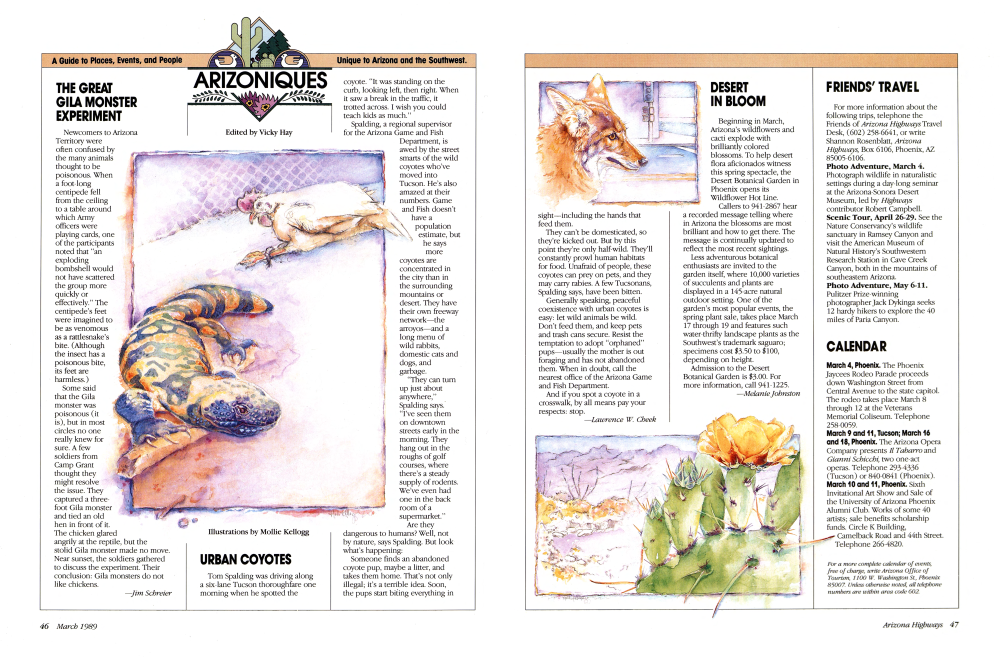ARIZONIQUES

A Guide to Places, Events, and People ARIZONIQUES Unique to Arizona and the Southwest. THE GREAT GILA MONSTER EXPERIMENT
Newcomers to Arizona Territory were often confused by the many animals thought to be poisonous. When a foot-long centipede fell from the ceiling to a table around which Army officers were playing cards, one of the participants noted that “an exploding bombshell would not have scattered the group more quickly or effectively.” The centipede's feet were imagined to be as venomous as a rattlesnake's bite. (Although the insect has a poisonous bite, its feet are harmless.) Some said that the Gila monster was poisonous (it is), but in most circles no one really knew for sure. A few soldiers from Camp Grant thought they might resolve the issue. They captured a threefoot Gila monster and tied an old hen in front of it. The chicken glared angrily at the reptile, but the stolid Gila monster made no move. Near sunset, the soldiers gathered to discuss the experiment. Their conclusion: Gila monsters do not like chickens.
Coyote. “It was standing on the curb, looking left, then right. When it saw a break in the traffic, it trotted across. I wish you could teach kids as much.” Spalding, a regional supervisor for the Arizona Game and Fish Department, is awed by the street smarts of the wild coyotes who've moved into Tucson. He's also amazed at their numbers. Game and Fish doesn't have a population estimate, but he says more coyotes are concentrated in the city than in the surrounding mountains or desert. They have their own freeway network-the arroyos-and a long menu of wild rabbits, domestic cats and dogs, and garbage.
“They can turn up just about anywhere,” Spalding says. “I've seen them on downtown streets early in the morning. They hang out in the roughs of golf courses, where there's a steady supply of rodents. We've even had one in the back room of a supermarket.” Are they dangerous to humans? Well, not by nature, says Spalding. But look what's happening: Someone finds an abandoned coyote pup, maybe a litter, and takes them home. That's not only illegal; it's a terrible idea. Soon, the pups start biting everything in
URBAN COYOTES
Tom Spalding was driving along a six-lane Tucson thoroughfare one morning when he spotted the Sight-including the hands that feed them.
They can't be domesticated, so they're kicked out. But by this point they're only half-wild. They'll constantly prowl human habitats for food. Unafraid of people, these coyotes can prey on pets, and they may carry rabies. A few Tucsonans, Spalding says, have been bitten.
Generally speaking, peaceful coexistence with urban coyotes is easy: let wild animals be wild. Don't feed them, and keep pets and trash cans secure. Resist the temptation to adopt "orphaned" pups-usually the mother is out foraging and has not abandoned them. When in doubt, call the nearest office of the Arizona Game and Fish Department.
And if you spot a coyote in a crosswalk, by all means pay your respects: stop.
DESERT IN BLOOM
Beginning in March, Arizona's wildflowers and cacti explode with brilliantly colored blossoms. To help desert flora aficionados witness this spring spectacle, the Desert Botanical Garden in Phoenix opens its Wildflower Hot Line.
Callers to 941-2867 hear a recorded message telling where in Arizona the blossoms are most brilliant and how to get there. The message is continually updated to reflect the most recent sightings.
Less adventurous botanical enthusiasts are invited to the garden itself, where 10,000 varieties of succulents and plants are displayed in a 145-acre natural outdoor setting. One of the garden's most popular events, the spring plant sale, takes place March 17 through 19 and features such water-thrifty landscape plants as the Southwest's trademark saguaro; specimens cost $3.50 to $100, depending on height.
Admission to the Desert Botanical Garden is $3.00. For more information, call 941-1225.
FRIENDS' TRAVEL
For more information about the following trips, telephone the Friends of Arizona Highways Travel Desk, (602) 258-6641, or write Shannon Rosenblatt, Arizona Highways, Box 6106, Phoenix, AZ 85005-6106.
Photo Adventure, March 4. Photograph wildlife in naturalistic settings during a day-long seminar at the Arizona-Sonora Desert Museum, led by Highways contributor Robert Campbell.
Scenic Tour, April 26-29. See the Nature Conservancy's wildlife sanctuary in Ramsey Canyon and visit the American Museum of Natural History's Southwestern Research Station in Cave Creek Canyon, both in the mountains of southeastern Arizona.
Photo Adventure, May 6-11. Pulitzer Prize-winning photographer Jack Dykinga seeks 12 hardy hikers to explore the 40 miles of Paria Canyon.
CALENDAR
March 4, Phoenix. The Phoenix Jaycees Rodeo Parade proceeds down Washington Street from Central Avenue to the state capitol. The rodeo takes place March 8 through 12 at the Veterans Memorial Coliseum. Telephone 258-0059.
March 9 and 11, Tucson; March 16 and 18, Phoenix. The Arizona Opera Company presents Il Tabarro and Gianni Schicchi, two one-act operas. Telephone 293-4336 (Tucson) or 840-0841 (Phoenix).
March 10 and 11, Phoenix. Sixth Invitational Art Show and Sale of the University of Arizona Phoenix Alumni Club. Works of some 40 artists; sale benefits scholarship funds. Circle K Building, Camelback Road and 44th Street. Telephone 266-4820.
For a more complete calendar of events, free of charge, write Arizona Office of Tourism, 1100 W. Washington St., Phoenix 85007. Unless otherwise noted, all telephone numbers are within area code 602.
Already a member? Login ».